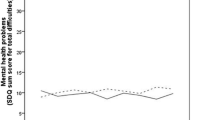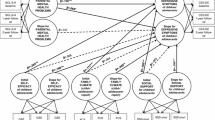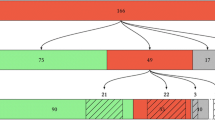Abstract
Background
Since prevalence rates of mental health problems in children and adolescents are high and of considerable relevance to public health, determinants of mental health, such as risk and protective factors, are of special interest.
Objectives
The present paper reports the frequencies and distributions of potential risk and protective factors and analyses their effects on children’s mental health.
Methods
The BELLA study is the mental health module of the German National Health Interview and Examination Survey among Children and Adolescents (KiGGS). Mental health problems and their assumed determinants are examined in a representative sub-sample of 2,863 families with children and adolescents aged 7–17. In order to identify mental health problems, the extended version of the Strengths and Difficulties Questionnaire was administered. Data on psychosocial risk factors as well as on protective factors in terms of personal, familial and social resources were collected by questioning the parents and, from the age of 11 years upwards, the children themselves.
Results
Adverse family climate stands out particularly as a negative contributor to children’s mental health. When several risk factors occur simultaneously, the prevalence of mental health problems increases markedly. Conversely, pronounced individual, family and social resources coincide with a reduced occurrence of mental health problems, especially in children with a limited number of risk factors.
Conclusions
The results suggest that differential prevention strategies are needed depending on the risk level: in the low risk group, to which most children belong, effective prevention programmes should define strengthening resources as a key objective. In the smaller group of children with a high number of risk factors, more complex intervention designs are required, which must consider the reduction of risks as well as strengthening resources.




Similar content being viewed by others
References
Amato PR (2001) Children of divorce in the 1990s: an update of the Amato and Keith (1991) meta-analysis. J Fam Psychol 15:355–370
Antonovsky A (1987) Unraveling the mystery of health. How people manage stress and stay well. Jossey-Bass, San Francisco
Asendorpf JB, van Aken MAG (1993) Deutsche Versionen der Selbstkonzeptskalen von Harter. Z Entwicklungspsychol Padagog Psychol 25:64–86
Barkmann C, Romer G, Watson M, Schulte-Markwort M (2007) Parental physical illness as a risk for psychosocial maladjustment in children and adolescents: epidemiological findings from a National Survey in Germany. Psychosomatics 48:476–481
Belfer ML (2008) Child and adolescent mental disorders: the magnitude of the problem across the globe. J Child Psychol Psychiatry 49:226–236
Bettge S, Ravens-Sieberer U (2003) Schutzfaktoren für die psychische Gesundheit von Kindern und Jugendlichen—empirische Ergebnisse zur Validierung eines Konzepts. Gesundheitswesen 65:167–172
Bettge S, Ravens-Sieberer U (2005) Seelische Gesundheit von Kindern und Jugendlichen in Deutschland—die Bella-Studie. Psychomed 17:214–222
Bradley RH, Corwyn RF (2002) Socioeconomic status and child development. Annu Rev Psychol 53:371–399
Briere JN, Elliott DM (1994) Immediate and long-term impacts of child sexual abuse. Future Child 4:54–69
Bullinger M, Kirchberger I (1998) SF-36 Fragebogen zum Gesundheits- zustand—Handanweisung. Hogrefe, Göttingen
Cohen J (1988) Analysis for the behavioral sciences, 2nd edn. Lawrence Erlbaum Associates, Inc, Hillsdale
Costello EJ, Egger H, Angold A (2005) 10-Year research update review: the epidemiology of child and adolescent psychiatric disorders: I. Methods and public health burden. J Am Acad Child Adolesc Psychiatry 44:972–986
Currie C, Samdal O, Boyce W, Smith R (eds) (2001) Health Behaviour in School-aged Children: a WHO Cross-National Study (HBSC), Research Protocol for the 2001/2002 Survey. Child and Adolescent Health Research Unit (CAHRU), University of Edinburgh
Darling N (1999) Parenting style and its correlates. ERIC Digest EDO-PS-99-3, Clearinghouse on Elementary and Early Childhood Education. University of Illinois, Illinois
Díaz R, Gual A, García M, Arnau J, Pascual F, Cañuelo B, Rubio G, de Dios Y, Fernández-Eire MC, Valdés R, Garbayo I (2008) Children of alcoholics in Spain: from risk to pathology: results from the ALFIL program. Soc Psychiatry Psychiatr Epidemiol 43:1–10
Donald CA, Ware JE (1984) The measurement of social support. Res Community Ment Health 4:325–370
Essex MJ, Kraemer HC, Armstrong JM, Boyce WT, Hill Goldsmith H, Klein MH, Woodward H, Kupfer DJ (2006) Exploring risk factors for the emergence of children’s mental health problems. Arch Gen Psychiatry 63:1246–1256
Ezzel CE, Cupit Swenson C, Brondino MJ (2000) The relationship of social support to physical abused children’s adjustment. Child Abuse Negle 24:641–651
Fergusson DM, Woodward LJ, Horwood LJ (1998) Maternal smoking during pregnancy and psychiatric adjustment in late adolescence. Arch Gen Psychiatry 55:721–727
Fergusson DM, Boden JM, Horwood LJ (2007) Exposure to single parenthood in childhood and later mental health, educational, economic, and criminal behavior outcomes. Arch Gen Psychiatry 64:1089–1095
Franke GH (2002) SCL-90-R. Die Symptom-Checkliste von Derogatis—Deutsche Version, 2nd edn. Beltz Test GmbH, Göttingen
Forehand R, Wierson M, Thomas A, Armstead L, Kempton T, Neighbors B (1991) The role of family stressors and parent relationships on adolescent functioning. J Am Acad Child Adolesc Psychiatry 30:316–322
Gandek B, Ware JE, Aaronson NK, Apolone G, Bjorner JB, Brazier JE, Bullinger M, Kaasa S, Leplege A, Prieto L, Sullivan M (1998) Cross-validation of item selection and scoring for the SF-12 health survey in nine countries results from the IQOLA Project. J Clin Epidemiol 51:1171–1178
Gardner F, Johnson A, Yudkin P, Bowler U, Hockley C, Mutch L, Wariyar U, Extremely Low Gestational Age Steering Group (2004) Behavioral and emotional adjustment of teenagers in mainstream school who were born before 29 weeks’ gestation. Pediatrics 114:676–682
Goodman R (1999) The extended version of the Strengths and Difficulties Questionnaire as a guide to child psychiatric caseness and consequent burden. J Child Psychol Psychiatry 40:791–799
Goodman R, Meltzer H, Bailey V (1998) The Strengths and Difficulties Questionnaire: a pilot study on the validity of the self-report version. Eur Child Adolesc Psychiatry 7:125–130
Goodman R, Ford P, Simmons H, Gatward R, Meltzer H (2000) Using the Strengths and Difficulties Questionnaire (SDQ) to screen for child psychiatric disorders in a community sample. Br J Psychiatry 177:534–539
Goodman R, Renfrew D, Mullick M (2000) Predicting type of psychiatric disorder from Strengths and Difficulties Questionnaire (SDQ) scores in child mental health clinics in London and Dhaka. Eur Child Adolesc Psychiatry 9:129–134
Grob A, Lüthi R, Kaiser FG, Flammer A, Mackinnon A, Wearing AJ (1991) Berner Fragebogen zum Wohlbefinden Jugendlicher (BFW) (Bernese questionnaire of subjective well-being). Diagnostica 37:66–75
Hammen C, Burge D, Burney E, Adrian C (1990) Longitudinal study of diagnoses in children of women with unipolar and bipolar affective disorder. Arch Gen Psychiatry 47:1112–1117
Hofferth SL, Reid L (2002) Early childbearing and children’s achievement and behaviour over time. Perspect Sex Reprod Health 34:41–49
Hysing M, Elgen I, Gillberg C, Lie SA, Lundervold AJ (2007) Chronic physical illness and mental health in children. Results from a large-scale population study. J Child Psychol Psychiatry 48:785–792
Ihle W, Esser G (2001) Epidemiologie psychischer Störungen im Kindes- und Jugendalter: Prävalenz, Verlauf, Komorbidität und Geschlechtsunterschiede. Psychol Rundsch 53:159–169
Jenkins JM, Smith MA (1991) Marital disharmony and children’s behaviour problems: aspects of a poor marriage that affect children adversely. J Child Psychol Psychiatry 32:793–810
Juang LP, Silbereisen RK (1999) Supportive parenting and adolescent adjustment across time in former East and West Germany. J Adolesc 22:719–736
Kinard EM (1998) Methodological issues in assessing resilience in maltreated children. Child Abuse Negl 22:669–680
Klocke A, Lampert T (2005) Armut bei Kindern und Jugendlichen. Gesundheitsberichterstattung des Bundes (GBE), 4 Robert Koch-Institut, Berlin
Lamborn SD, Mounts NS, Steinberg L, Dornbusch SM (1991) Pattern of competence and adjustment among adolescent from authoritative, authoritarian, indulgent and neglectful families. Child Dev 62:1049–1065
Lange M, Kamtsiuris P, Lange C, Schaffrath-Rosario A, Stolzenberg H, Lampert T (2007) Messung soziodemographischer Merkmale im Kinder- und Jugendgesundheitssurvey (KiGGS) und ihre Bedeutung am Beispiel der Einschätzung des allgemeinen Gesundheitszustands. Bundesgesundheitsbl Gesundheitsforsch Gesundhe- itsschutz 50:578–589
Laucht M, Esser G, Schmidt MH (1997) Wovor schützen Schutzfaktoren? Anmerkungen zu einem populären Konzept der modernen Gesundheitsforschung. Z Entwicklungspsychol Padagog Psychol 29:260–270
Luthar SS (1993) Methodological and conceptual issues in research on childhood resilience. J Child Psychol Psychiatry 34:441–453
Masten AS, Reed M-GJ (2002) Resilience in development. In: Snyder CR, Lopez SJ (eds) The handbook of positive psychology. University Press, Oxford, pp 74–88
McLeod JD, Kaiser K (2004) Childhood emotional and behavioral problems and educational attainment. Am Sociol Rev 69:636–658
Palfrey JS, Tonniges TF, Green M, Richmond J (2005) Introduction: addressing the millennial morbidity—the context of community. Pediatrics 115:1121–1123
Patel V, Flisher AJ, Hetrick S, McGorry P (2007) Mental health of young people: a global public-health challenge. Lancet 369:1302–1313
Ravens-Sieberer U, Kurth B-M, KiGGS study group, BELLA study group (2008) The mental health module (BELLA study) within the German Health Interview and Examination Survey of Children and Adolescents (KiGGS): study design and methods. Eur Child Adolesc Psychiatry 17(Suppl1):10–21
Roberts RE, Attkisson CA, Rosenblatt A (1998) Prevalence of psychopathology among children and adolescents. Am J Psychiatry 155:715–725
Rutter M, Yule B, Quinton D, Rowlands O, Yule W, Berger M (1975) Attainment and adjustment in two geographical areas: III. Some factors accounting for area differences. Br J Psychiatry 126:520–533
Rutter M (1979) Protective factors in children’s responses to stress and disadvantage. In: Kent MW, Rolf JE (eds) Primary prevention in psychopathology: social competence in children. University Press of New England, Hanover, pp 49–74
Rutter M (1987) Psychosocial resilience and protective mechanisms. Am J Orthopsychiatry 57:316–331
Rutter M, Quinton D (1984) Parental psychiatric disorder: effects on children. Psychol Med 14:853–880
Rutter M, Tizard J, Yule W, Graham P, Whitmore K (1976) Isle of Wight studies 1964–1974. Psychol Med 6:313–332
Sameroff AJ, Seifer R, Bartko WT (1997) Environmental perspectives on adaptation during childhood and adolescence. In: Luthar SS, Burack JA, Cicchetti D, Weisz J (eds) Developmental psychopathology: perspectives on adjustment risk and disorder. Cambridge University Press, New York, pp 507–526
Scheier MF, Carver CS (1985) Optimism, coping and health: assessment and implications of generalized outcome expectancies. Health Psychol 4:219–247
Scheithauer H, Petermann F (1999) Zur Wirkungsweise von Risiko- und Schutzfaktoren in der Entwicklung von Kindern und Jugendlichen. Kindheit und Entwicklung 8:3–14
Schneewind K, Beckmann M, Hecht-Jackl A (1985) Familienklima-Skalen. Bericht 8.1 und 8.2. Institut für Psychologie–Persönlichkeitspsychologie und Psychodiagnostik. Ludwig Maximilians Universität, München
Schwarzer R (1994) Optimistische Kompetenzerwartung: Zur Erfassung einer personalen Bewältigungsressource. Diagnostica 40:105–123
Schwarzer R, Jerusalem M (1999) Skalen zur Erfassung von Lehrer- und Schülermerkmalen. Dokumentation der psychometrischen Verfahren im Rahmen der Wissenschaftlichen Begleitung des Modellversuchs Selbstwirksame Schulen. Institut für Psychologie, Freie Universität Berlin, Berlin
Starfield B, Riley A, Ensminger M, Green B, Ryan S, Kim-Harris S, Johnston D, Vogel K (1994) Manual for the Child Health and Illness Profile-Adolescent Edition (CHIP-AETM). The Johns Hopkins University, Baltimore, MD
Trautmann-Villalba P, Gerhold M, Laucht M, Schmidt MH (2004) Early motherhood and disruptive behaviour in the school-age child. Acta Paediatr 93:120–125
van Aken MAG, Asendorpf JB, Wilpers S (1996) Das soziale Unterstützungsnetzwerk von Kindern: Strukturelle Merkmale, Grad der Unterstützung, Konflikte und Beziehung zum Selbstwertgefühl. Psychologie Erziehung Unterricht 43:114–126
Werner E (1995) Resilience in development. Curr Dir Psychol Sci 4:81–85
Werner EE, Smith RS (1982) Vulnerable but invincible: a study of resilient children. McGraw-Hill, New York
Werner EE, Smith RS (1992) Overcoming the odds: high risk children from birth to adulthood. Cornell University Press, Ithaca
Williams JH, Ross L (2007) Consequences of prenatal toxin exposure for mental health in children and adolescents: a systematic review. Eur Child Adolesc Psychiatry 16:243–253
Winkler J, Stolzenberg H (1999) Der Sozialschichtindex im Bundes-Gesundheitssurvey. Das Gesundheitswesen 61(Sonderheft 2):178–183
Conflict of interest
All authors declare no conflict of interest.
Author information
Authors and Affiliations
Consortia
Corresponding author
Additional information
Members of the BELLA study group: Ulrike Ravens-Sieberer (Principal Investigator), Claus Barkmann, Susanne Bettge, Monika Bullinger, Manfred Döpfner, Michael Erhart, Beate Herpertz-Dahlmann, Heike Hölling, Franz Resch, Aribert Rothenberger, Michael Schulte-Markwort, Nora Wille, Hans-Ulrich Wittchen.
Rights and permissions
About this article
Cite this article
Wille, N., Bettge, S., Ravens-Sieberer, U. et al. Risk and protective factors for children’s and adolescents’ mental health: results of the BELLA study. Eur Child Adolesc Psychiatry 17 (Suppl 1), 133–147 (2008). https://doi.org/10.1007/s00787-008-1015-y
Published:
Issue Date:
DOI: https://doi.org/10.1007/s00787-008-1015-y




